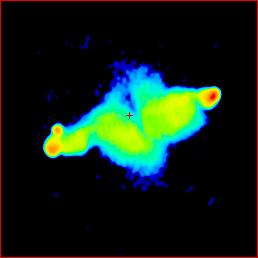 Image:
Image:3C 20 | B0040+517 |
| S178 | Alpha | FR | Class | ID | Spectrum | Best z | mag. | LAS | lg P178 | D |
|---|---|---|---|---|---|---|---|---|---|---|
| 46.8 | 0.66 | II | CD | Gal | 0.174 | R(c) = 19* | 53.10 | 26.34 | 135.1 |

| Size: | 76.8 × 76.8 arcsec² |
|---|---|
| LUT: | Logarithmic |
| Beam: | 1.5 arcsec |
| Frequency: | 1407 MHz |
| Method: | CLEAN Õ˜ÿ>1.5
|
| Telescope: | VLA A |
| Credits: | R. A. Laing (unpublished) |
3C 20 has been most studied for its bright multiple hotspots. The one in the east lobe is a classic example, with a compact "primary" to the north and a more diffuse secondary to the south, facing away from the primary, and so suggesting that the jet is deflected at the primary and sprays out to form the secondary. The hotspots were first mapped at high resolution by Laing (1982) and more recently by Fernini et al. (1997) and Hardcastle et al. (1997a). The western hotspot is also double, with a smaller separation.
Hardcastle et al. identify low-contrast features in the lobes which they believe to be emission from the jets; these are not visible in our image due to its lower resolution.
3C 20 is also one of a handful of DRAGNs to show optical emission from a hotspot (the compact western one). Detailed spectral modelling is given by Meisenheimer et al. (1997).
The radio spectrum of the hotspots and lobes, up to 85 GHz, has
been studied by Hardcastle & Looney (2001).
| Prev. | Data Page | Other images | Next | Search | Alphanumeric List | Icon List | Atlas Index |
|---|